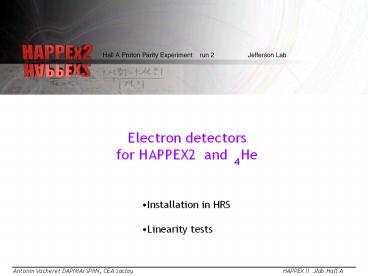Electron detectors for HAPPEX2 and He PowerPoint PPT Presentation
Title: Electron detectors for HAPPEX2 and He
1
Electron detectors for HAPPEX2 and He
4
- Installation in HRS
- Linearity tests
2
Detectors
3
Installation
Installation procedure to be tested next week in
the Hall
Coordinate with installation of scanners
4
Linearity and Asymmetry
- Output signal of the PMT
- Asymmetry measured
The nonlinear term is proportional to the signal
amplitude.
- HAPPEX requirement
5
Mode of operation of the tube
- Integrating mode
- High beam intensity (80 100 mA)
- Rate in HRS t 50 MHz in the whole detector
- Low gain region
- Continuous signal less than 6 mA to match ADC
range - Pulse mode
- - Background study and Q2 measurement
- Low beam intensity (factor 200 less counting
rate to fire VDCs) - Rate in HRS t 10 KHz/cm2
- High gain region
- pulse signal of a few mA
- need large dynamic range and good
linearity capability
33 ms
6
PULSE mode linearity setup
Method
Blue LED (430 nm)
-HV
Att dB
Att dB
8854 BURLE PMT
Deviation from linearity
ADC
Remote Filter wheels
Pulse generator
La
Lf
Normalization (1st order)
S(La)
S(Lf)
Ped
Light flux
PMT response
7
PULSE mode linearity
Active base
Resistive base
2
2
Operating range
250
250
Nge-
Nge-
- Non linearity at high gain due to saturation in
latter dynodes - operating range is in a good
linearity region
8
Linearity in continuous mode setup
Shutter 1
Method Use of additivity
Shutter 2
-HV
Micro Amperemetre
DC voltage
Plans to implement this method online for the
HAPPEX-2 run
9
Linearity in continuous mode
Resistive base
Active base
ADC range
2
Results for average continuous current Is the
pulse structure still relevant ? Evaluation of
the real output current is done with a duty
factor of 2 or 3
10
Gain drift
Measurement of Drift in gain with a pulse signal
and a load of continuous light background of 1,
5, 15 mA
Load ON
Load OFF
Gain do depends on output current but timescale
very long. no systematics from rate-gain
correlation at 30 Hz
11
conclusion
- Complete tests of linearity for the BURLE 8854
base - Resistive base H gain G
1E6-3E6 output 2-8 mA L gain G
5E3-1E4 output 10-20 mA filters
(0.5,0.2,0.1) - Active base H gain G
1E6-1E7 output 2-20 mA L gain G
1E4-2E4 output 20-40 mA filter (0.1)
PowerShow.com is a leading presentation sharing website. It has millions of presentations already uploaded and available with 1,000s more being uploaded by its users every day. Whatever your area of interest, here you’ll be able to find and view presentations you’ll love and possibly download. And, best of all, it is completely free and easy to use.
You might even have a presentation you’d like to share with others. If so, just upload it to PowerShow.com. We’ll convert it to an HTML5 slideshow that includes all the media types you’ve already added: audio, video, music, pictures, animations and transition effects. Then you can share it with your target audience as well as PowerShow.com’s millions of monthly visitors. And, again, it’s all free.
About the Developers
PowerShow.com is brought to you by CrystalGraphics, the award-winning developer and market-leading publisher of rich-media enhancement products for presentations. Our product offerings include millions of PowerPoint templates, diagrams, animated 3D characters and more.

